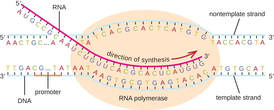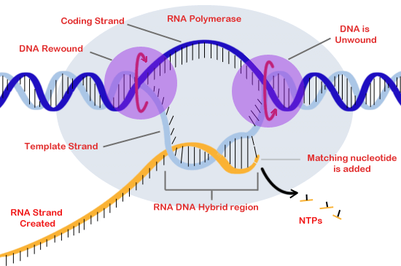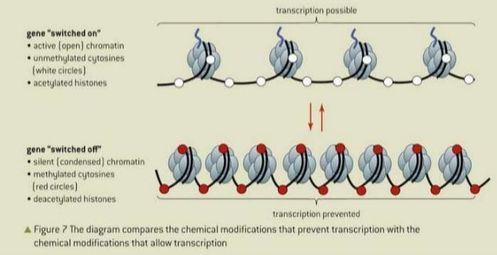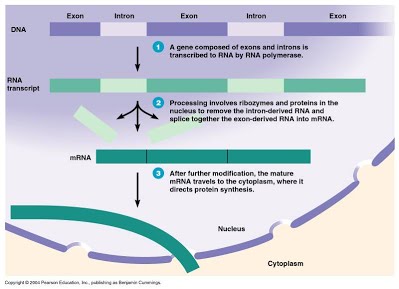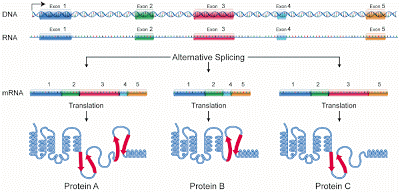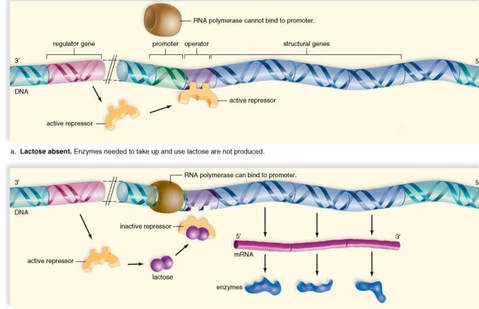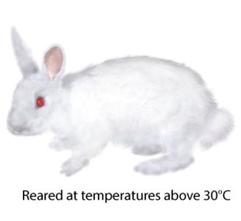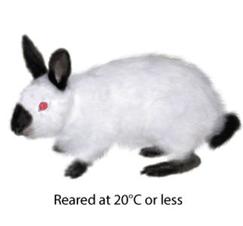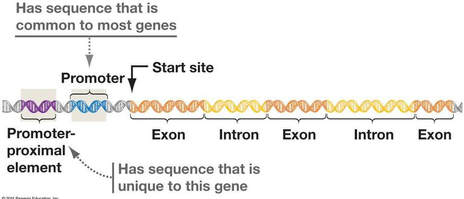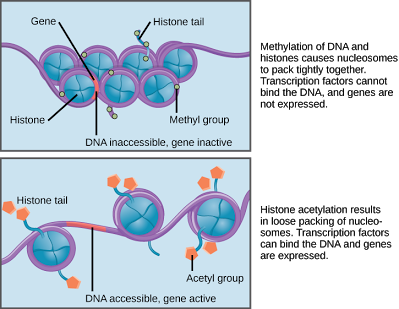- IB Style Question Banks with Solution
- IB DP Biology SL- IB Style Practice Questions with Answer-Topic Wise-Paper 1
- IB DP Biology HL- IB Style Practice Questions with Answer-Topic Wise-Paper 1
- IB DP Biology SL- IB Style Practice Questions with Answer-Topic Wise-Paper 2
- IB DP Biology HL- IB Style Practice Questions with Answer-Topic Wise-Paper 2
7.2 Transcription and Gene Expression
Essential Idea:
Information stored as a code in DNA is copied onto mRNA
Understandings:
- Transcription occurs in a 5’ to 3’ direction
- Nucleosomes help to regulate transcription in eukaryotes
- Eukaryotic cells modify mRNA after transcription
- Splicing of mRNA increases the number of different proteins an organism can produce
- Gene expression is regulated by proteins that bind to specific base sequences in DNA
- The environment of a cell and of an organism has an impact on gene expression
Applications:
- The promoter as an example of non-coding DNA with a function
Skills:
- Analysis of changes in the DNA methylation patterns
- Define gene expression.
- State two reasons why gene expression must be regulated.
- Outline the environmental regulation of the breakdown of lactose in E. coli.
- Outline the role of enhancers, silencers and promoter-proximal elements in regulation of gene expression.
- Describe the use of twin studies to measure the impact of environment on gene expression.
- Outline two examples of environmental influence on gene expression.
- Outline the effect of methylation of nucleosome tails on rates of gene expression.
- Outline the effect of acetylation of nucleosome tails on rates of gene expression.
- Describe the initiation of transcription, including the role of the promoter, transcription factors, the TATA box and RNA polymerase.
- Describe elongation of transcription, including the role of nucleotide triphosphates and the direction of transcription.
- Describe termination of transcription, including the role of the terminator.
- List two major differences in gene expression between prokaryotic cells and eukaryotic cells.
- Describe the three post-transcriptional modifications of pre-mRNA in eukaryotes.
- Describe the process of alternative RNA splicing.
- Outline an example of alternative splicing the results in different protein products.
- Outline the role of promoter DNA.
- State the effect of DNA methylation on gene expression.
- Compare methylation patterns in twins using superimposed images of dyed chromosomes.
- Define epigenetic and epigenome.
- List types of epigenetic tags.
- Discuss the role of reprogramming and imprinting on epigenetic factors.
Topic 7.2 Transcription and Gene Expression
In the Transcription and Gene Expression unit we will extend our knowledge on Topic 2.7 DNA Replication, Transcription and Translation. We will also look at how the environment can influence gene expression.
This unit will last 3 school days
Essential idea:
- Information stored as a code in DNA is copied onto mRNA.
Nature of science:
- Looking for patterns, trends and discrepancies—there is mounting evidence that the environment can trigger heritable changes in epigenetic factors. (3.1)
7.2 U 1 Transcription occurs in a 5’ to 3’ direction. (Guidance: RNA polymerase adds the 5′ end of the free RNA nucleotide to the 3′ end of the growing mRNA molecule)
- Define gene expression.
- State two reasons why gene expression must be regulated.
- Outline the environmental regulation of the breakdown of lactose in E. coli.
- Outline the role of enhancers, silencers and promoter-proximal elements in regulation of gene expression.
Transcription occurs in a 5’ to 3’ direction where the 5’ end of the free RNA nucleotide is added to the 3’ end of the RNA molecule that is being synthesized. Transcription begins when the RNA polymerase binds to the promoter with the help of specific binding proteins. Transcription consists of 3 stages called initiation, elongation and termination
A. Initiation: RNA polymerase is an enzyme complex which:
- unwinds and unzips DNA double strand
- attaches to promoter region of gene, which marks the beginning point for transcription
- attaches with assistance of transcription factors
- binds to DNA anti-sense strand
- the sense strand is the coding strand and has the same base sequence as mRNA, with uracil instead of thymine
- the anti-sense strand is transcribed and has the same base sequence as tRNA, with uracil instead of thymine
B. Elongation: RNA polymerase:
- uses DNA anti-sense strand as a template
- synthesizes a complementary RNA strand from nucleoside triphosphate taken from the surrounding solution in 5’ to 3’ direction
- adds nucleoside triphosphates using base pairing rules
A = U T = A G = C C = G
- uses energy from hydrolysis of phosphates from nucleoside triphosphates
C. Termination: RNA polymerase :
- reaches termination region of the gene, which marks the end of the coding sequence
- terminates transcription by releasing both DNA and RNA
7.2 U 2 Nucleosomes help to regulate transcription in eukaryotes.
- Describe the use of twin studies to measure the impact of environment on gene expression.
- Outline two examples of environmental influence on gene expression.
Eukaryotic DNA wraps around histone proteins and supercoils. This supercoiling helps regulate transcription because only certain areas of the DNA are accessible for the production of mRNA by transcription. This regulates the production of a polypeptide. One of the main ways this occurs is through the modification of the histone tails
- When acetyl groups are added to the positively charged histone tails, they become negative and the DNA repels against them. This opens up the nucleosome so the DNA is not as close to the histone anymore and chromatin remodeling can occur.
- This acetylation of the positive histone tails and opening up of the DNA structure allows the gene to be transcribed more often.
- If this does not occur, the DNA remains tightly packed and transcription is inhibit
7.2 U 3 Eukaryotic cells modify mRNA after transcription.
- Outline the effect of methylation of nucleosome tails on rates of gene expression.
- Outline the effect of acetylation of nucleosome tails on rates of gene expression.
In eukaryotes, the locations for transcription and translation are separated by the nuclear membrane. This allows for post-transcriptional modification of the mRNA. The first product of transcription is pre-mRNA
- As eukaryotic mRNA travels from the nucleus to the ribosomes, non-coding strands of the mRNA called introns are removed to form functional mature mRNA.
- They are removed through RNA splicing
- The exons are spliced together to form mature mRNA
- Also a poly A tail consisting of approximately 100-200 adenine nucleotides is added to one end of the mRNA and a 5’ cap is added to the other end (these help protect the mature mRNA transcript)
7.2.U 4 Splicing of mRNA increases the number of different proteins an organism can produce.
- Describe the initiation of transcription, including the role of the promoter, transcription factors, the TATA box and RNA polymerase.
- Describe elongation of transcription, including the role of nucleotide triphosphates and the direction of transcription.
- Describe termination of transcription, including the role of the terminator.
Alternative splicing can occur with genes that produce multiple proteins, which means that some exons may also be removed during splicing, thus producing different polypeptides
- For example, in mammals tropomyosin which is a protein involved in muscle contractions; however, the pre-mRNA is spliced to form 5 different forms of the protein. The mature mRNA that codes for tropomyosin in the smooth muscle of the intestines is missing exon 3 and 10, while the mRNA that codes for tropomyosin in skeletal muscle is missing exon 2.
7.2.U5 Gene expression is regulated by proteins that bind to specific base sequences in a DNA
- List two major differences in gene expression between prokaryotic cells and eukaryotic cells.
- Describe the three post-transcriptional modifications of pre-mRNA in eukaryotes.
Gene expression can also be regulated by the environment surrounding the gene that is expressed or repressed. Specific proteins can regulate how much transcription of a particular gene will occur. These include proteins called enhancers, silencers and promoter-proximal elements
- These regulatory proteins are unique to a particular gene
- Regulatory sequences on the DNA that increase the rate of transcription when proteins bind to them are called enhancers
- Regulatory sequences on the DNA that decrease the rate of transcription when proteins bind to them are called silencers
- Promoter-proximal elements have binding sites closer to the promoter and their binding is necessary to initiate transcription
- In prokaryotic cells such as E.coli repressor proteins block the production the enzymes needed to break down lactose in the cell.
- However, when Lactose is present, it will bind to the repressor protein, causing it to fall off, and allowing transcription to occur.
- As transcription occurs, these enzymes are made and lactose is broken down into glucose and galactose. Since there is small amounts of lactose now in the cell, the repressor binds again to the operator, blocking transcription from taking place.
- This is an example of negative feedback
7.2.U6 The environment of a cell and of an organism has an impact on gene expression
- Describe the process of alternative RNA splicing.
- Outline an example of alternative splicing the results in different protein products.
The external environment in which the organism is located or develops, as well as the organism’s internal world, which includes such factors as its hormones and metabolism can have an impact on gene expression. Temperature and light are external conditions which can affect gene expression in certain organisms.
- For example, Himalayan rabbits carry the C gene, which is required for the development of pigments in the fur, skin, and eyes, and whose expression is regulated by temperature (Sturtevant, 1913).
- Specifically, the C gene is inactive above 35°C, and it is maximally active from15°C to 25°C. This temperature regulation of gene expression produces rabbits with a distinctive coat coloring. In the warm, central parts of the rabbit’s body, the gene is inactive, and no pigments are produced therefore the fur color is white (picture right). In the rabbit’s extremities (i.e., the ears, tip of the nose, and feet), where the temperature is much lower than 35°C, the C gene actively produces pigment, making these parts of the animal black.
During embryonic development embryos contain chemicals called morphogens, which can affect gene expression and thereby affecting the fate of embryonic cells depending on their position within the embryo.
- An obvious example is how sunlight affects the production of skin pigmentation in humans
- A chemical example, was the use of Thalidomide by pregnant woman for morning sickness. It was thought it was harmless for humans but was not thoroughly tested. The drug was withdrawn too late to prevent severe developmental deformities in approximately 8,000 to 12,000 infants, many of whom were born with stunted limb development. Interestingly, despite the fact that thalidomide is dangerous during embryonic development, the drug continues to be used in certain instances yet today.
7.2 A 1 The promoter as an example of non-coding DNA with a function.
- Outline the role of promoter DNA.
7.2 S 1 Analysis of changes in the DNA methylation patterns.
- State the effect of DNA methylation on gene expression.
- Compare methylation patterns in twins using superimposed images of dyed chromosomes.

